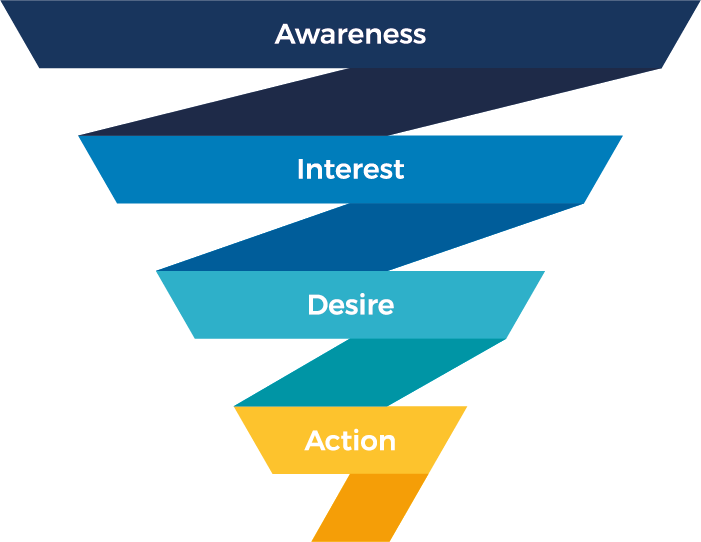It’s no secret that digital PR is a top-of-the-funnel activity.
When we’re investing in promotion through this channel, we need to recognize that the chances of a visitor to our content then deciding to make a purchase is far slimmer than it would be if they had come through a bottom of funnel activity like PPC.
Now, that doesn’t mean we can’t be talking about the revenue impact of a digital PR campaign – because, especially when we take an integrated approach, we can.
But it also means that digital PR deserves greater recognition than we currently tend to give it. And that means understanding the cross-funnel impact the channel can have.
What Do We Mean by a ‘Funnel’?
Fans of marketing frameworks will be aware of the marketing funnel.
The idea that consumers move through a linear journey may be somewhat simplistic, but it can help us to better understand:
- How our target audiences are behaving.
- What part of the journey we’re impacting along the way.
According to the AIDA model, consumers move through a journey of:
- Awareness – First becoming aware of the problem or solution.
- Interest – Becoming interested in the solution offered.
- Desire – Wanting the solution offered.
- Action – Buying the solution offered.
Digital PR, then, sits at the top of the funnel.
It’s about raising awareness, whether that’s through traffic to the campaign itself, or increasing visibility for the brand in the SERPs by improving their ranking positions.
Conversely, something like PPC is much more driven to targeting consumers at the point of conversion (especially if we’re talking about search ads and Google Shopping).
How Does Digital PR Contribute to the Funnel?
The way that digital PR in its purest sense contributes to the funnel is, as mentioned above, through increasing awareness amongst the target audience.
When done well, it’s about getting the brand in front of its audience with messages that start to build relationships that could lead to conversion eventually.
It should, therefore, be intrinsically tied to tangible, measurable goals such as number of links built and resulting ranking, and therefore traffic improvements.
It can also contribute to the rest of the funnel and has the greatest potential to do so when:
- We craft campaigns that sit at the very core of the Circles of Focus (a technique I’ve been using with my clients to prioritize content production).
- We integrate our campaigns with other channels.
Here are four ways that you can drive higher returns from your digital PR campaigns by capitalizing on its cross-funnel potential.
1. Integrate PR with SEO – Properly
The thing about digital PR is that it was originally born from SEO. It was a need to drive links that got us to this point of investing in campaigns to earn us links.
But let’s not forget that back before we got news-savvy, we built links in plenty of other ways and we always did it with very clear goals in mind.
It was rare (unless we were just starting out with a new website) that we’d want to build links to just anywhere.
Homepage links were cool, but we knew that the true value lay in direct links because equity did not degrade by being passed across internal links.
To put it simply, we tried to point our links to deeper pages – those pages we wanted to rank – and we thought about things like the position of the link in the linking page and anchor text as means to squeeze even more value from our work.
So it makes logical sense that we should not be briefing our digital PR teams with anything less than a clear, SEO-driven goal.
“Just get links” is not a brief.
“Get the links to wherever” is not a brief.
“Build me links to X page directly or via equity passage with a view to increasing rankings for X keyword”: now that’s a brief.
Every SEO professional needs to brief PRs with SEO knowledge and PRs need to seek that insight from their SEO partners.
Integrate with SEO properly.
2. Borrow from Traditional PR – But Make It Measurable
Another way to show more value from your digital PR campaigns is to call on the other discipline that made it – traditional PR.
If digital PR is the baby, SEO and traditional PR are the parents.
That’s because, while SEO was informing digital PR to build links, traditional PR was inspiring it to use new techniques to do so.
In a post-Penguin world, digital PRs are investing ever more in great content, news hooks, and even PR stunts, much as traditional PRs have done and still do.
So it goes to follow that digital PR is already giving you the benefits of its traditional predecessor. But we aren’t measuring it particularly well – yet.
And, hey, it’s understandable. Traditional PRs are still chatting about advertising value equivalent (AVE) and circulation and other frankly fluffy metrics.
And if they can’t articulate the value of their work, how can we?
Obviously, that’s a rhetorical question. Because we’re digital marketers and the core value of digital lies in the fact that it is tangible and measurable.
Which means that yes, we can make traditional PR metrics measurable. We just have to do a bit of work on it.
The first step is to make your traditional PR metrics S.M.A.R.T. – specific, measurable, achievable, relevant, and time-based.
It’s an old marketing framework but no less valuable today than when it was first created, in my opinion.
What it means is that we make the intangible tangible.
For example, “awareness” might be measured through ranking improvements, keyword visibility, and share of voice of branded search.
Bottom line: we owe it to ourselves as digital PRs to be judged on traditional PR metrics because those are benefits we’re already delivering, but we must must make it measurable.
3. Think About the Wider Benefits of Our Assets
If your PR campaign involves the creation of some kind of asset (as most do), you should be considering the potential additional value of those assets.
Whether it’s a quiz, an infographic, a video or even a fake job ad, if you’re creating an asset to accompany your digital PR campaigns, you should be considering the broader benefits therein.
For example, you might work with your SEO team to work out what format of content you can produce to support on-page optimization efforts.
Equally, you might share those assets with your wider team. I’ve had various clients who used the articles we landed for them as collateral in their sales discussions.
If you’re doing email marketing, you might use this content, too.
4. Consider Funnel Campaigns
A funnel campaign is a campaign which uses digital PR as the primary interaction point, but then has a clear journey/path for the consumer to follow through to conversion.
How, then, can we use PR alongside PPC/paid media?
PPC pros are – particularly in the case of paid social or remarketing – trying to build broader audiences to whom they can then send targeted messages to encourage them through to an eventual conversion goal.
And PRs are creating top of the funnel content that builds broader audiences.
It’s logical, then, that the two should work together.
Why not explore using paid media techniques to capitalize on your popular campaigns?
Use cookie tracking to build remarketing audiences, and make one of your KPIs relate to remarketing audience size.
Then work closely with your paid media team (and broader marketing team/client) to understand the conversion journey that usually follows that first interaction.
Create strategic ads or additional content to send to the most engaged users at every level and, eventually, you’ll be able to show how your digital PR campaign has driven a tangible ROI.
The Evolution of Digital PR
The discipline of digital PR is still in its relative infancy, especially when compared to something like SEO.
As digital marketers, we have the opportunity to shape that evolution.
Let’s stop shouting about how many links we’ve built, and started celebrating the broader benefits of digital PR, too.
I’d love to know what you think; drop me a comment!
More Resources:
- 5 Benefits of Digital PR Which Aren’t Links
- 6 Content Strategies to Boost Your Digital PR & Link Building Success
- Link Building for Beginners: How to Get Started
Image Credits
Screenshot taken by author, July 2019



